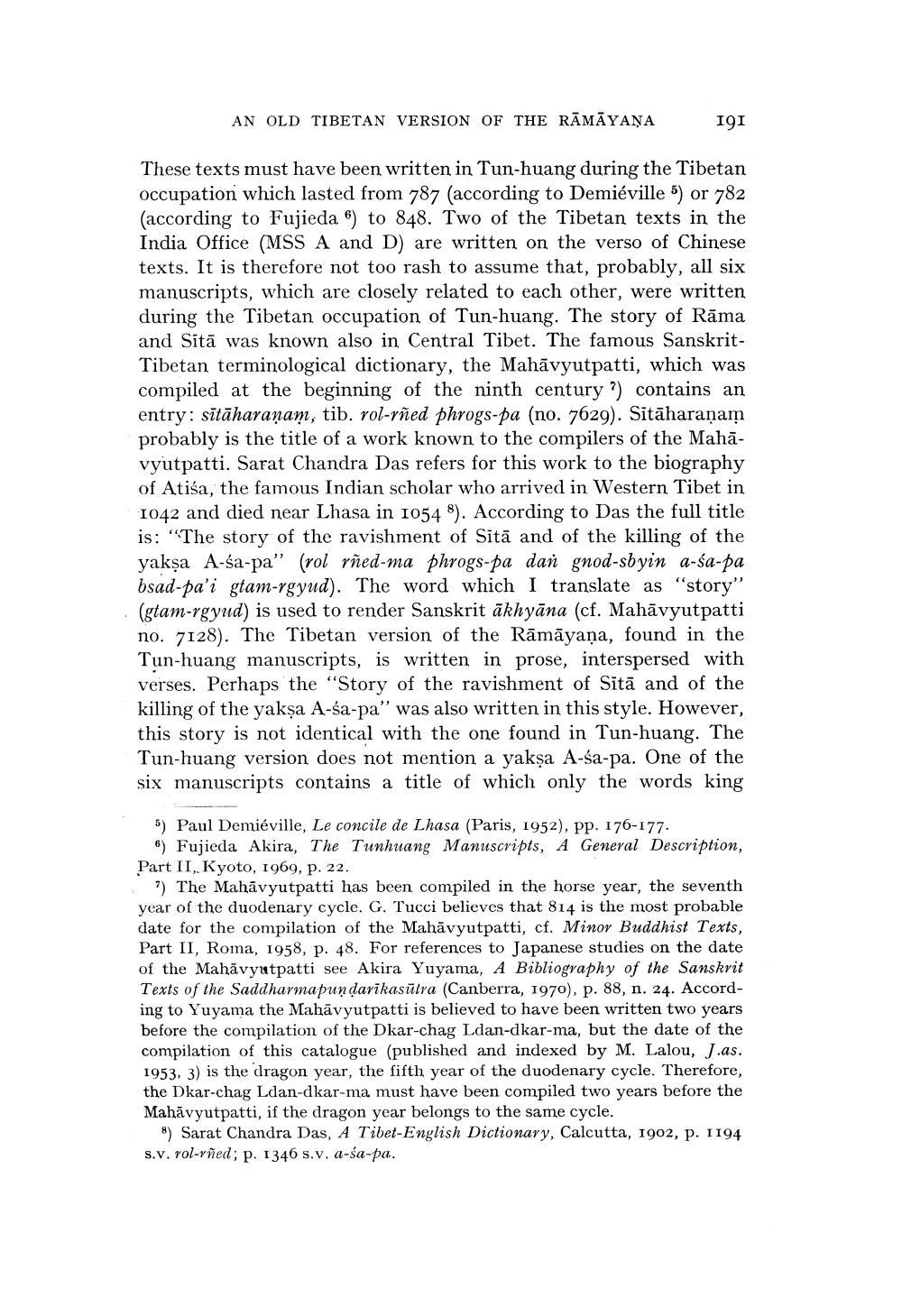Book Title: An Old Tibetan Version Of Ramayana Author(s): J W De Jong Publisher: J W De Jong View full book textPage 2
________________ AN OLD TIBETAN VERSION OF THE RĀMĀYAŅA 191 These texts must have been written in Tun-huang during the Tibetan occupation which lasted from 787 (according to Demiéville 5) or 782 (according to Fujieda 6) to 848. Two of the Tibetan texts in the India Office (MSS A and D) are written on the verso of Chinese texts. It is therefore not too rash to assume that, probably, all six manuscripts, which are closely related to each other, were written during the Tibetan occupation of Tun-huang. The story of Rāma and Sitā was known also in Central Tibet. The famous SanskritTibetan terminological dictionary, the Mahāvyutpatti, which was compiled at the beginning of the ninth century ) contains an entry: sītāharaṇam, tib, rol-rñed phrogs-pa (no. 7629). Sītāharanam probably is the title of a work known to the compilers of the Mahāvyutpatti. Sarat Chandra Das refers for this work to the biography of Atisa, the famous Indian scholar who arrived in Western Tibet in 1042 and died near Lhasa in 1054 8). According to Das the full title is: "The story of the ravishment of Sitā and of the killing of the yaksa A-sa-pa" (rol rñed-ma phrogs-pa dan gnod-sbyin a-sa-pa bsad-pa'i gtam-rgyud). The word which I translate as “story" (gtam-rgyud) is used to render Sanskrit ākhyāna (cf. Mahāvyutpatti no. 7128). The Tibetan version of the Rāmāyaṇa, found in the Tun-huang manuscripts, is written in prose, interspersed with verses. Perhaps the “Story of the ravishment of Sītā and of the killing of the yakṣa A-sa-pa" was also written in this style. However, this story is not identical with the one found in Tun-huang. The Tun-huang version does not mention a yakşa A-sa-pa. One of the six manuscripts contains a title of which only the words king 5) Paul Demiéville, Le concile de Lhasa (Paris, 1952), pp. 176-177. 6) Fujieda Akira, The Tunhuang Manuscripts, A General Description, Part II, Kyoto, 1969, p. 22. ?) The Mahāvyutpatti has been compiled in the horse year, the seventh year of the duodenary cycle. G. Tucci believes that 814 is the most probable date for the compilation of the Mahāvyutpatti, cf. Minor Buddhist Texts, Part II, Roma, 1958, p. 48. For references to Japanese studies on the date of the Mahāvyutpatti see Akira Yuyama, A Bibliography of the Sanskrit Texts of the Saddharmapundarīkasūtra (Canberra, 1970), p. 88, n. 24. According to Yuyama the Mahāvyutpatti is believed to have been written two years before the compilation of the Dkar-chag Ldan-dkar-ma, but the date of the compilation of this catalogue (published and indexed by M. Lalou, J.as. 1953, 3) is the dragon year, the fifth year of the duodenary cycle. Therefore, the Dkar-chag Ldan-dkar-ma must have been compiled two years before the Mahāvyutpatti, if the dragon year belongs to the same cycle. 8) Sarat Chandra Das, A Tibet-English Dictionary, Calcutta, 1902, p. 1194 s.v. rol-rñed; p. 1346 s.v. a-sa-pa.Page Navigation
1 2 3 4 5 6 7 8 9 10 11 12 13
